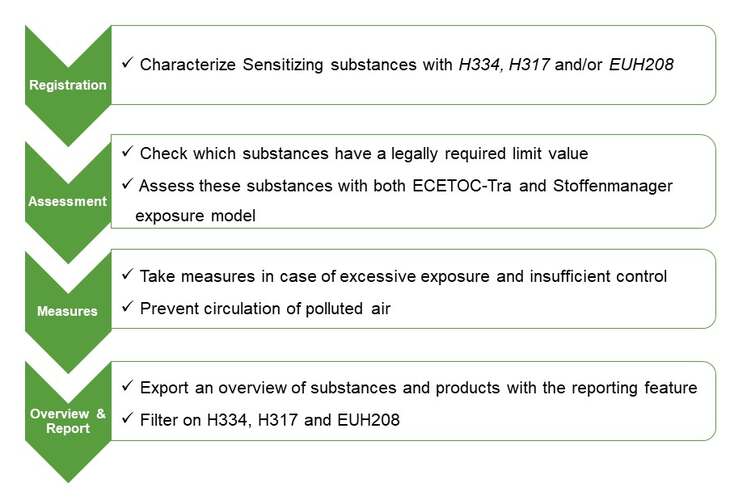In addition to CMR substances, more and more attention is being paid to sensitizing substances in the workplace. More often, inspectorate is asking companies about exposure and management strategy of sensitizing chemicals. In this blog we elaborate on sensitizing substances and the application of Chemrade to comply with legislation and regulations.
Sensitizing substances
Sensitizing substances are also called allergens and are substances that - upon exposure - can cause a hypersensitive reaction by the immune system. Isocyanates, epoxy resins and the well-known grass pollen are examples of sensitizing substances and basically can be found in every industry. In case of exposure via inhalation and/or skin contact, the immune system kicks in and an allergic reaction takes place. This manifests itself in inflammatory reactions that can result in chronic effects such as allergic eczema, asthma, or COPD.
Sensitizing substances can be recognized by the following H-phrases:
- H317: ''May cause an allergic reaction''
- H334: ''May cause allergy or asthma symptoms or breathing difficulties if inhaled''
- EUH208: "Contains <name of sensitizing substance>. May produce an allergic reaction."
How to control sensitizing substances with Chemrade
With Chemrade, it is possible to keep sight on sensitizing substances in the workplace and take accurate control measures upon excessive exposure. To get everything in order, the next steps can be taken:
1. Registration
Register substances using the SDS in which sensitizing substances are labeled with H334, H317 and/or EUH208. Substances registered from the Chemrade Substance Database are automatically provided with the correct H-phrases.
2. Exposure assessment
Some sensitizing substances have a legal occupational exposure level (OEL) to adhere to. Substances subscribed from the Chemrade Substances Database are foreseen with the OEL defined by Dutch legislation. Depending on the workplace and activity, these substances are then assessed with both the ECETOC-Tra model and Stoffenmanager exposure model. In addition to exposure due to inhalation, the ECETOC-Tra model also includes the impact on skin.

3. Measures
In case of excessive exposure and insufficient control, the employer is obliged to take measures. In Chemrade, the impact of various control measures can be simulated, after which the most ideal measure can be implemented. For uncontrolled allergens, it is recommended to provide good ventilation and prevent circulation of contaminated air.
4. Overview and reporting
Perhaps the most important step is creating a clear and comprehensive overview of the sensitizing substances within the company and the impact and control measures in case of exposure. With Chemrade's reporting feature, you can easily export all registered substances and products to an Excel overview. Next apply filters to the excel document and filter on the H-phrases (H317 and H334) and EUH208. The result is a simple though accurate overview of all sensitizing substances including their exposure assessments and measures.
In short, sensitizing substances can pose risks for your employees when exposed to them and are therefore important to control. Chemrade enables you to easily create an overview of sensitizing substances, risks and control measures in a way that satisfies employees, management, and inspection.
Would you like to know more about Chemrade?